Navajo Spiny Oyster and Silver Necklace and Earrings - C3776ZD
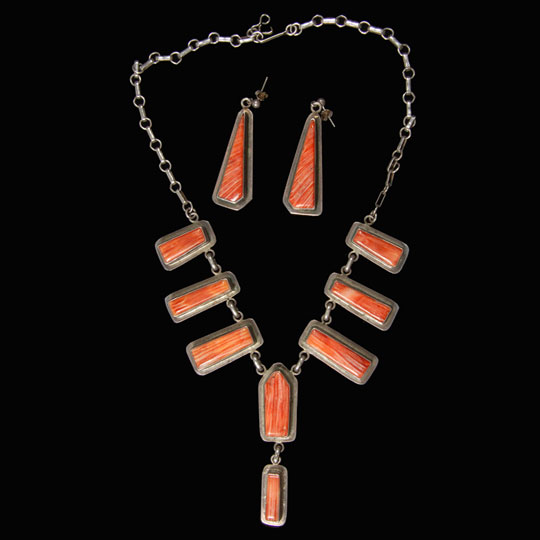 The official name of the shell used in this necklace is Spondylus and it is from a bivalve mollusk. Additionally, it is known as thorny oyster or spiny oyster. The many species of Spondylus are grouped in the same superfamily as the scallops. They are not closely related to true oysters, however, they do cement themselves to rocks, rather than attach themselves by a byssus. Like scallops, Spondylus have multiple eyes around the edges of their shells, and have relatively well-developed nervous systems. Spondylus shells are much sought after by collectors, and a lively commercial market exists for them.
The official name of the shell used in this necklace is Spondylus and it is from a bivalve mollusk. Additionally, it is known as thorny oyster or spiny oyster. The many species of Spondylus are grouped in the same superfamily as the scallops. They are not closely related to true oysters, however, they do cement themselves to rocks, rather than attach themselves by a byssus. Like scallops, Spondylus have multiple eyes around the edges of their shells, and have relatively well-developed nervous systems. Spondylus shells are much sought after by collectors, and a lively commercial market exists for them.
Northeastern California Mono Indian Bottleneck Basket - C3776X
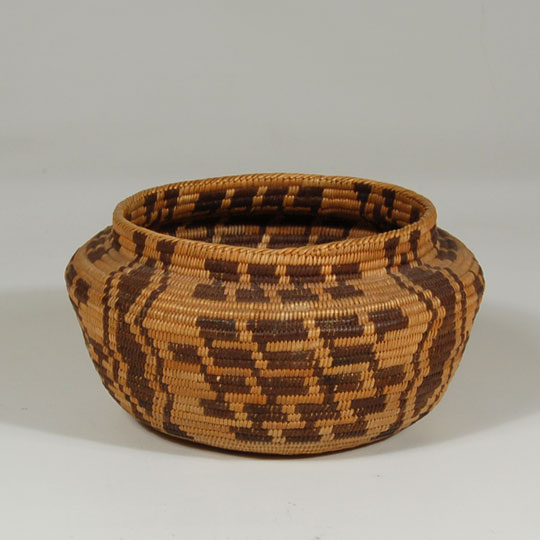 I am inclosing a quotation by George Wharton James from his book, published in 1903, because I feel it describes the Mono Indians and a particular basket maker in beautiful detail.
I am inclosing a quotation by George Wharton James from his book, published in 1903, because I feel it describes the Mono Indians and a particular basket maker in beautiful detail.
"Just below the Yosemite Valley, east and south, a nation of aboriginal basket-makers is to be found. One of the counties of California, as well as a noted lake, are named after them-Monos. Little by little the lands owned by their ancestors have been stolen from them, and now they are driven in every direction higher and higher into the mountains. With an indifference to their rights that is very different from the passionate rebellion of such people as the Apaches, they have allowed themselves to be dispossessed of their homes, and have climbed away further from the white man. Doubtless the reason for this seeming indifference is to be found in the fact that there is plenty more valuable land in the higher Sierras which they can use for their simple pastoral wants.
Original Painting “I am a Warrior” by Quincy Tahoma - C3775D
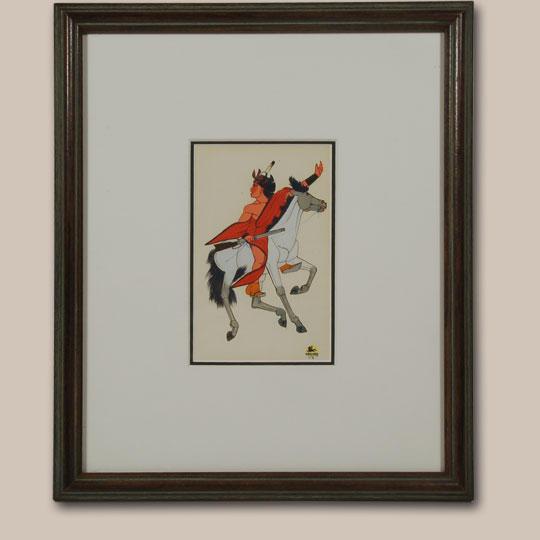 Quincy Tahoma loved action scenes and painted many such scenes during his career. This one is a good illustration of a young Navajo warrior wrapped in a red blanket. He holds a rifle in his right hand while he is glancing back at something which the viewer cannot see. The horse is very actively running. The young man has his left arm up in the air as if he is calling for others to join him.
Quincy Tahoma loved action scenes and painted many such scenes during his career. This one is a good illustration of a young Navajo warrior wrapped in a red blanket. He holds a rifle in his right hand while he is glancing back at something which the viewer cannot see. The horse is very actively running. The young man has his left arm up in the air as if he is calling for others to join him.
Polished Black Rectangular Lidded Box by Rose Gonzales - C3776L
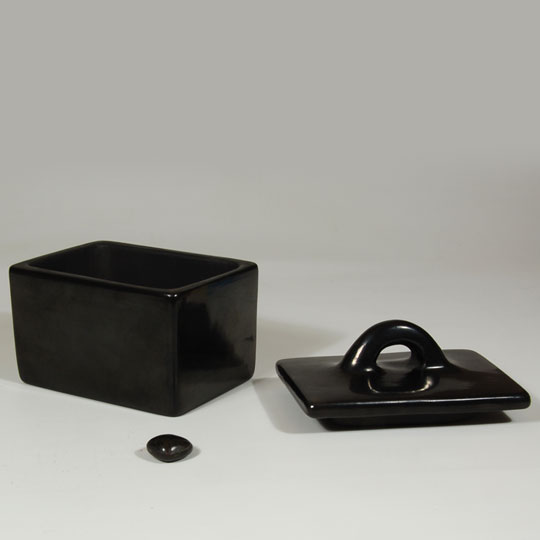 The use of cornmeal in pueblo ceremonials is well established as is the use by individuals at their homes. Cornmeal is used as a medium for bestowing blessings on something or someone much as holy water is used by the Catholic Church. There may or may not be a correlation between the two.
The use of cornmeal in pueblo ceremonials is well established as is the use by individuals at their homes. Cornmeal is used as a medium for bestowing blessings on something or someone much as holy water is used by the Catholic Church. There may or may not be a correlation between the two.
This rectangular black cornmeal lidded box was made by Rose Gonzales probably in the second half of the 20th century. It is a perfectly plain, undecorated stone-polished box finished to a beautiful sheen. The box is signed Rose on the underside.
Historic Zia Pueblo High-shoulder Storage Jar - C3753.01
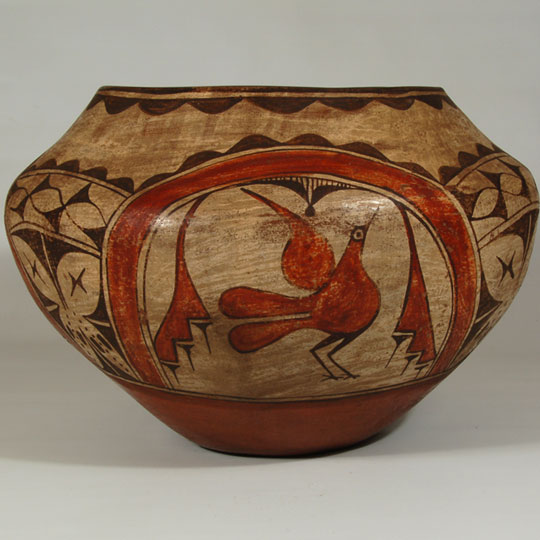 This is an excellent polychrome storage jar that dates to the first decade of the twentieth century (circa 1910-1920), as evidenced by the overall form: the high shoulder, typical of pieces created post 1900, the stone polished underbody of the vessel, as well as the traditional red banding at the top of the underbody, which fell into disuse circa 1930.
This is an excellent polychrome storage jar that dates to the first decade of the twentieth century (circa 1910-1920), as evidenced by the overall form: the high shoulder, typical of pieces created post 1900, the stone polished underbody of the vessel, as well as the traditional red banding at the top of the underbody, which fell into disuse circa 1930.
The piece is constructed of typical Zia basaltic black lava as paste-temper with the traditional polished red neck interior and a black rim top, though ceremonial breaks in the framing lines are absent. The design elements are faithful to the traditionally conservative Zia design system, which itself is relatively unchanged by the influence of Western ideas.
Tesuque Pueblo Head View of Deer Dancer by Patrick Swazo Hinds - C3720F
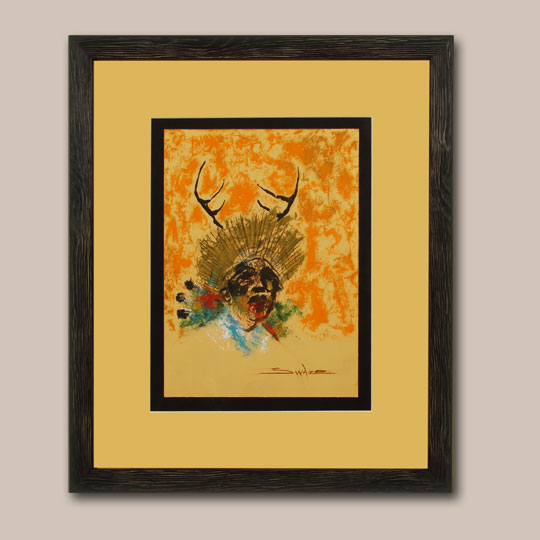 Patrick Swazo was born at Tesuque Pueblo in 1929 and given the name José Patricio Swazo. He was adopted by Dr. Norman A. E. Hinds, honorary member of Tesuque Pueblo and Professor of Geology at the University of California for 45 years. Not long after his adoption, Swazo moved to California where he resided until his death. He usually spent his summers at the pueblo. He served in the United States Marine Corps and served in Korea. His education included attendance at High School in Berkeley, California; Hill and Canyon School of Arts in Santa Fe, New Mexico; California College of Arts and Crafts in Oakland; Mexico City College, Mexico City; and the Art Institute of Chicago.
Patrick Swazo was born at Tesuque Pueblo in 1929 and given the name José Patricio Swazo. He was adopted by Dr. Norman A. E. Hinds, honorary member of Tesuque Pueblo and Professor of Geology at the University of California for 45 years. Not long after his adoption, Swazo moved to California where he resided until his death. He usually spent his summers at the pueblo. He served in the United States Marine Corps and served in Korea. His education included attendance at High School in Berkeley, California; Hill and Canyon School of Arts in Santa Fe, New Mexico; California College of Arts and Crafts in Oakland; Mexico City College, Mexico City; and the Art Institute of Chicago.
Swazo became a full-time painter after 1968 but most of his paintings are not dated. He died in 1974 so it can be assumed that most of his art was produced in the 6 years between 1968 and 1974. He also produced lithographs as well as original paintings.
Santa Clara Pueblo Original Painting “Mimbres Antelope” by Helen Hardin - C3775B
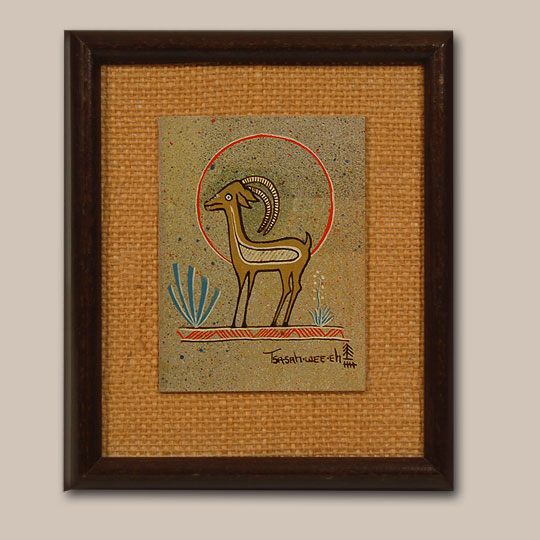 This wonderful acrylic painting depicts a Mimbres-style ram or antelope reminiscent of petroglyph drawings one would see on ancient rock walls. The background is a prototypical example of the detailed style in which Helen often worked. As is always the case with her, the execution of line and form is impeccable.
This wonderful acrylic painting depicts a Mimbres-style ram or antelope reminiscent of petroglyph drawings one would see on ancient rock walls. The background is a prototypical example of the detailed style in which Helen often worked. As is always the case with her, the execution of line and form is impeccable.
The warm earthy tones and charmingly intimate scale of this piece are assets of strength not normally associated with a work of this scale. The painting is signed in lower right in dark paint, Tsa-sah-wee-eh with the artist's cartouche.
Santa Clara Pueblo Original Painting “Mimbres Fish” by Helen Hardin - C3775C
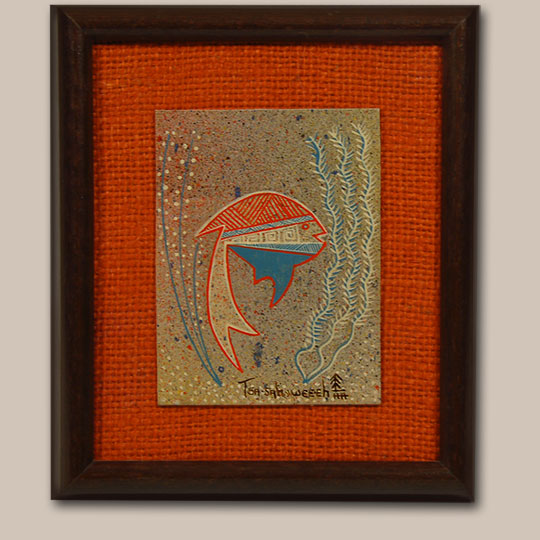 Helen Hardin, from the very beginning of her career, was at the cutting edge of Indian-influenced art. Her art, though obviously drawing on her Indian heritage and tradition, was very much in the mainstream of modern aesthetics. This small acrylic painting on artist board does not reflect a date. It is a simple painting of a fish but a work exhibiting exceptional drafting skills and superlative technical rendering. It is quite exceptional and striking, as the work of Helen Hardin tends to be, with a true sense of the complexities and intricacies involved in the creation of such a work.
Helen Hardin, from the very beginning of her career, was at the cutting edge of Indian-influenced art. Her art, though obviously drawing on her Indian heritage and tradition, was very much in the mainstream of modern aesthetics. This small acrylic painting on artist board does not reflect a date. It is a simple painting of a fish but a work exhibiting exceptional drafting skills and superlative technical rendering. It is quite exceptional and striking, as the work of Helen Hardin tends to be, with a true sense of the complexities and intricacies involved in the creation of such a work.
Pencil Drawing “Superstition Mountain” by Joseph Imhof - C3720E
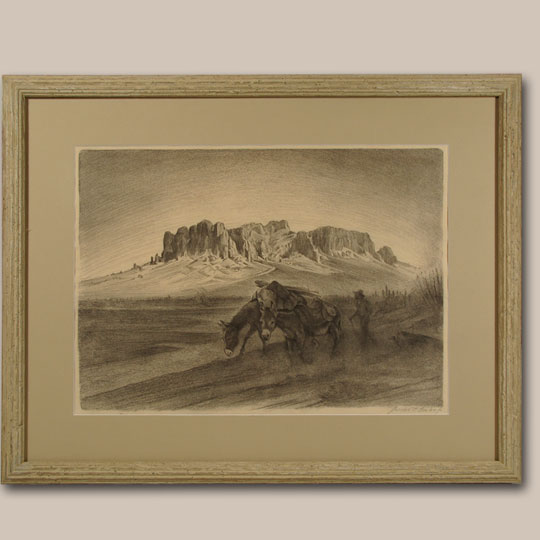 In 1905, Joseph Imhof and his wife went to the Southwest for the first time to record ceremonies of Pueblo Indians. He built a studio in Albuquerque in 1906 and traveled throughout the region and then lived in New York before settling in Taos in 1929. In Taos, he built his studio on the edge of the reservation facing the Sacred Mountain behind Taos Pueblo.
In 1905, Joseph Imhof and his wife went to the Southwest for the first time to record ceremonies of Pueblo Indians. He built a studio in Albuquerque in 1906 and traveled throughout the region and then lived in New York before settling in Taos in 1929. In Taos, he built his studio on the edge of the reservation facing the Sacred Mountain behind Taos Pueblo.
Tall Polished Santa Clara Pueblo Black Bear Paw Jar by Severa Tafoya - C3771D
 Severa Tafoya never received the publicity she should have. She was an extraordinary potter during the 1950s and 1960s, but pottery was not in the mainstream then as it is now. Had today's collectors been collecting pottery in the mid-1900s, she would have been high on their list. Very few collectors today know who she was and how fine her pottery is. She was an active potter for almost 60 years.
Severa Tafoya never received the publicity she should have. She was an extraordinary potter during the 1950s and 1960s, but pottery was not in the mainstream then as it is now. Had today's collectors been collecting pottery in the mid-1900s, she would have been high on their list. Very few collectors today know who she was and how fine her pottery is. She was an active potter for almost 60 years.
Santa Clara Pueblo Black Melon Jar by Angela Baca - C3771E
 Angela Baca is most likely represented in every collection of contemporary pottery with one of her black melon jars, the style and shape that has been associated with her since the 1960s. She was probably the first potter to produce melon jars. I recall that the very first purchase I made at The Covered Wagon in Albuquerque in the 1960s was a black melon jar by Angela Baca at a price of $35. I was so impressed when I saw it that I put it on lay-away immediately.
Angela Baca is most likely represented in every collection of contemporary pottery with one of her black melon jars, the style and shape that has been associated with her since the 1960s. She was probably the first potter to produce melon jars. I recall that the very first purchase I made at The Covered Wagon in Albuquerque in the 1960s was a black melon jar by Angela Baca at a price of $35. I was so impressed when I saw it that I put it on lay-away immediately.
Mojave Four-spout Effigy Vessel by Elmer Gates - C3774B
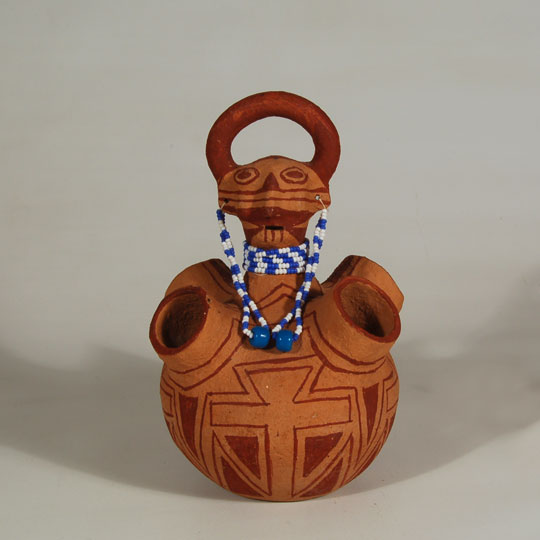 Generally, Mojave men were not potters, but Elmer Gates, who was born in 1929 and lived in Poston, Arizona, on the Fort Mohave Reservation, was an exception. He had learned to make pottery from his aunt. He then continued studying all styles of southwestern pottery and working with various techniques. He sold his work at the Colorado River Indian Tribal Museum in the 1970s. Gates was so confident in his chosen profession that he taught a number of young artists of Mojave and Maricopa tribes, as well as non-natives. Santa Fe ceramicist Rick Dillingham studied with Gates.
Generally, Mojave men were not potters, but Elmer Gates, who was born in 1929 and lived in Poston, Arizona, on the Fort Mohave Reservation, was an exception. He had learned to make pottery from his aunt. He then continued studying all styles of southwestern pottery and working with various techniques. He sold his work at the Colorado River Indian Tribal Museum in the 1970s. Gates was so confident in his chosen profession that he taught a number of young artists of Mojave and Maricopa tribes, as well as non-natives. Santa Fe ceramicist Rick Dillingham studied with Gates.
Original Painting “Tucked Away” by Laurence Sisson - C2820L
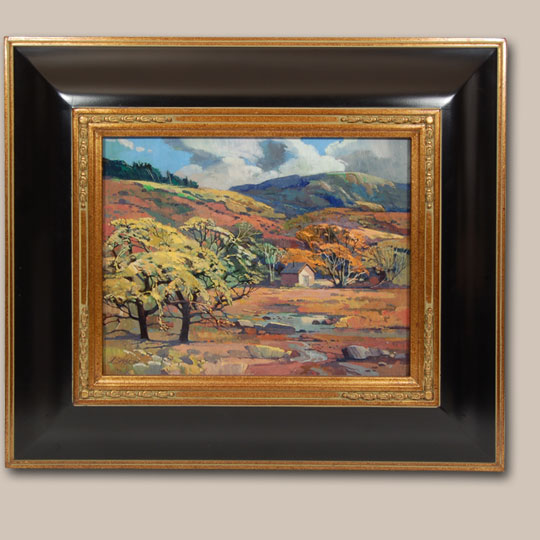 Laurence Sisson established his art reputation by making paintings of the Maine Coast for the first 30 years of his art career. He then moved to New Mexico and easily adapted to painting Southwest landscapes. He was a proficient plein-air, painter in watercolors and oils, depicting nature as he saw it.
Laurence Sisson established his art reputation by making paintings of the Maine Coast for the first 30 years of his art career. He then moved to New Mexico and easily adapted to painting Southwest landscapes. He was a proficient plein-air, painter in watercolors and oils, depicting nature as he saw it.
Hopi Polychrome Jar with Deep Red Pigment by Mark Tahbo - 25855
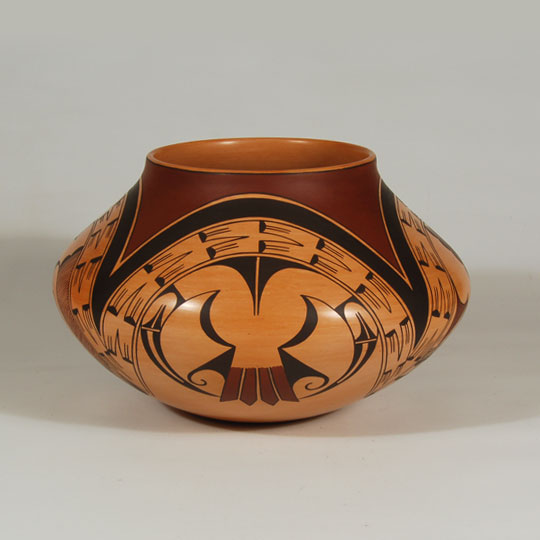 When Mark Tahbo delivers pottery to the gallery he always spends considerable time explaining each and every item of design. He treats each vessel as a special item and wants to be sure that we understand what he did and why he did it. I sometimes wish I had recorded his words rather than attempting to remember them.
When Mark Tahbo delivers pottery to the gallery he always spends considerable time explaining each and every item of design. He treats each vessel as a special item and wants to be sure that we understand what he did and why he did it. I sometimes wish I had recorded his words rather than attempting to remember them.
Hopi Polychrome Jar with Dual Red Pigments by Mark Tahbo - 25856
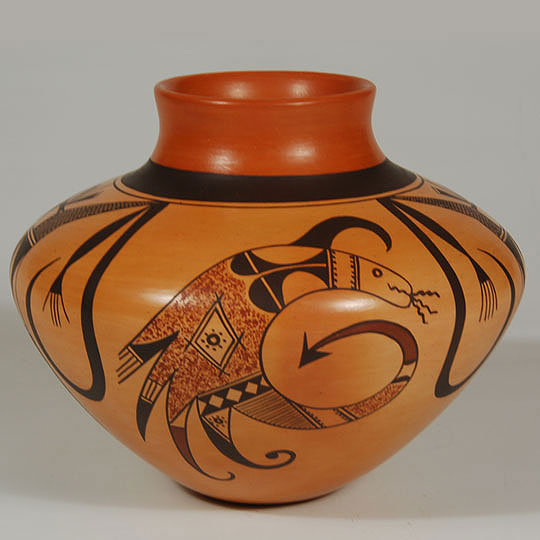 This jar is one with pictorial design elements, as probably one could say regarding all Sikyatki and Sikyatki-revival jar designs, since most of them feature some form of stylized bird elements, however, this one features two designs of the Plumed Serpent. The Hopi version, as seen on prehistoric Hopi pottery, is different from the manner in which the New Mexico Tewa Pueblos present their version of the Plumed Serpent or Avanyu. Of course, these versions as presented on this jar could be Mark Tahbo's imagination and artist license taking control. The diamond on the body of one of the serpents represents the house where the serpent resides according to Hopi legend. Mark admitted that the serpent might resemble an octopus in some people's mind but that is not the intent.
This jar is one with pictorial design elements, as probably one could say regarding all Sikyatki and Sikyatki-revival jar designs, since most of them feature some form of stylized bird elements, however, this one features two designs of the Plumed Serpent. The Hopi version, as seen on prehistoric Hopi pottery, is different from the manner in which the New Mexico Tewa Pueblos present their version of the Plumed Serpent or Avanyu. Of course, these versions as presented on this jar could be Mark Tahbo's imagination and artist license taking control. The diamond on the body of one of the serpents represents the house where the serpent resides according to Hopi legend. Mark admitted that the serpent might resemble an octopus in some people's mind but that is not the intent.
Hopi Sikyatki Revival Seed Jar by Elva Tewaguna Nampeyo - C3762D
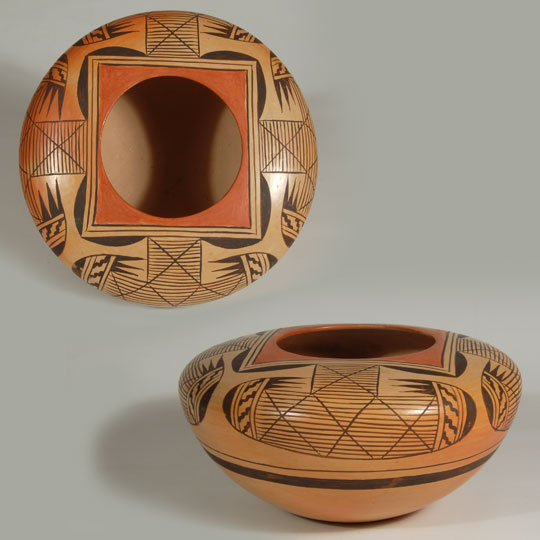 Elva Tewaguna Nampeyo was a granddaughter of Nampeyo of Hano and daughter of Fannie Nampeyo. She has been gone over 30 years now so there are not many of her wares on the market, and there certainly are not many of this magnificence. She was an exceptional potter and her work never deteriorated later in her life when she became ill. She certainly was one of the exceptional potters of her generation.
Elva Tewaguna Nampeyo was a granddaughter of Nampeyo of Hano and daughter of Fannie Nampeyo. She has been gone over 30 years now so there are not many of her wares on the market, and there certainly are not many of this magnificence. She was an exceptional potter and her work never deteriorated later in her life when she became ill. She certainly was one of the exceptional potters of her generation.
Mineral Earth Painting of a Family of Roadrunners by Pablita Velarde - C3772
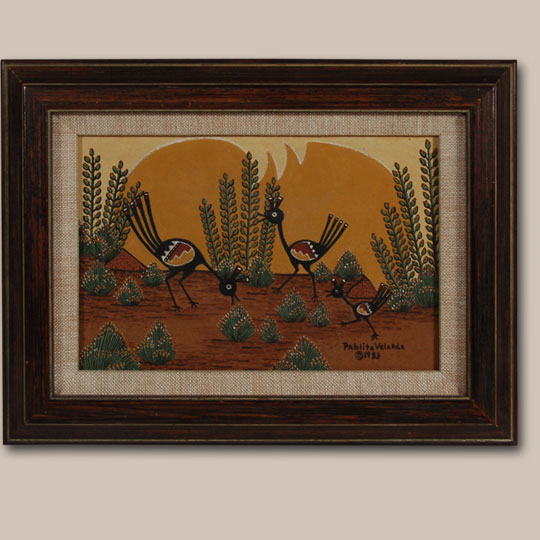 After meeting Dorothy Dunn at The Studio at the Santa Fe Indian School, Pablita Velarde was convinced that a career in painting was her calling. She had been inspired by watching Tonita Peña pursue an art career and was actually encouraged by Peña to pursue art as a career.
After meeting Dorothy Dunn at The Studio at the Santa Fe Indian School, Pablita Velarde was convinced that a career in painting was her calling. She had been inspired by watching Tonita Peña pursue an art career and was actually encouraged by Peña to pursue art as a career.
We are fortunate that she pursued the career of her choice. We now have a collection of art that is truly inspiring. She revived the art of painting with earth minerals. Preparation of the paints was a laborious task that took days of grinding pigments on a metate using a mano.
Black Pottery Bear Paw Jar from Santa Clara Pueblo by Angela Baca - C3771A
 Angela might be considered the Matriarch of the first family of Santa Clara melon potters. She was a melon pot specialist who made various sizes in both red and black and she made the same shape jars but with bear paws instead of melon ribs. She undoubtedly had one of the longest potting careers in Santa Clara Pueblo. Her pottery is in the collections of the National Museum of the American Indian of the Smithsonian Institution, The Wheelwright Museum of the American Indian and other numerous museums and galleries.
Angela might be considered the Matriarch of the first family of Santa Clara melon potters. She was a melon pot specialist who made various sizes in both red and black and she made the same shape jars but with bear paws instead of melon ribs. She undoubtedly had one of the longest potting careers in Santa Clara Pueblo. Her pottery is in the collections of the National Museum of the American Indian of the Smithsonian Institution, The Wheelwright Museum of the American Indian and other numerous museums and galleries.
Santa Clara Pueblo Black Pottery Bear Paw Jar by Angela Baca - C3771B
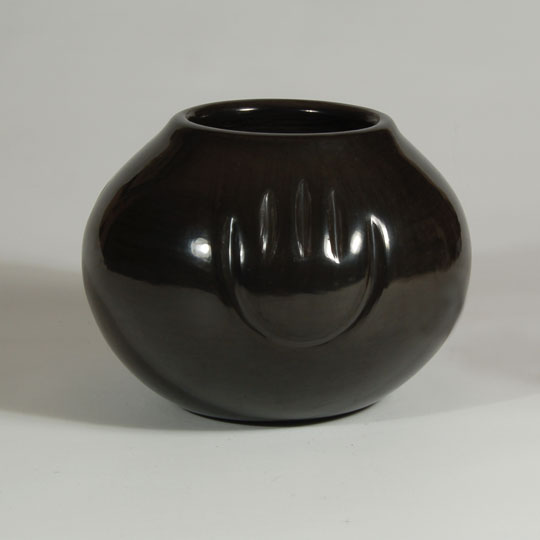 Angela Baca has long been associated with her ability to produce beautiful red and black jars, some with melon ribs and others with bear paw depressions into the clay. Works in these styles are first coil-formed with a large diameter coil of clay and allowed to dry to a leather-hard state, whereupon they are carved with the distinctive ribs or bear paw depressions. After carving, the pottery is slipped in iron-bearing red slip, intricately stone-polished and then fired in either a smothered, reduction atmosphere to achieve the superb black finish or in an oxidizing atmosphere to achieve the red finish.
Angela Baca has long been associated with her ability to produce beautiful red and black jars, some with melon ribs and others with bear paw depressions into the clay. Works in these styles are first coil-formed with a large diameter coil of clay and allowed to dry to a leather-hard state, whereupon they are carved with the distinctive ribs or bear paw depressions. After carving, the pottery is slipped in iron-bearing red slip, intricately stone-polished and then fired in either a smothered, reduction atmosphere to achieve the superb black finish or in an oxidizing atmosphere to achieve the red finish.
Zia Pueblo Polychrome Deep Serving Bowl - C3753.27
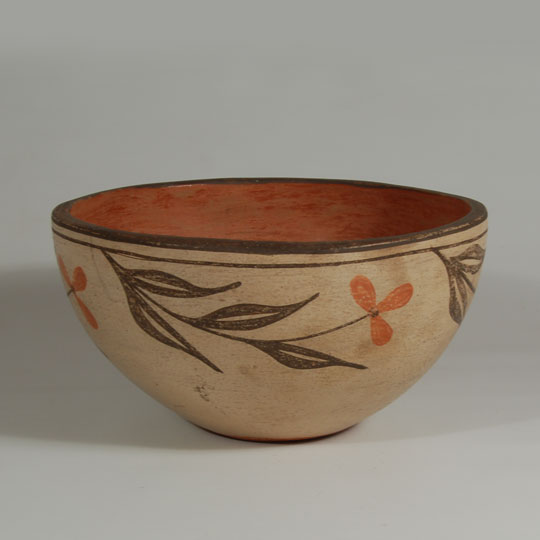 There were probably more bowls made in New Mexico Pueblos than there were jars. Very large bowls, called dough bowls, were used for preparing bread dough; medium-size ones were used for preparation of tortilla dough, serving food at the table or for storage and even overturned as a lid for covering jars; the smallest bowls were used for daily meals.
There were probably more bowls made in New Mexico Pueblos than there were jars. Very large bowls, called dough bowls, were used for preparing bread dough; medium-size ones were used for preparation of tortilla dough, serving food at the table or for storage and even overturned as a lid for covering jars; the smallest bowls were used for daily meals.
This bowl would be of the medium size and probably used as stated above. Most of the polished red slip on the interior has been rubbed from constant use so the bowl appears to have had an extensive life at the pueblo before entering the marketplace. It has a very traditional Zia design of floral elements over a cream slip. The underbody is slipped in red clay.

